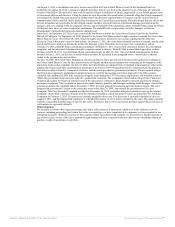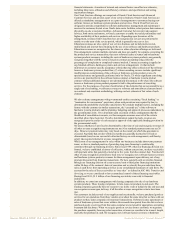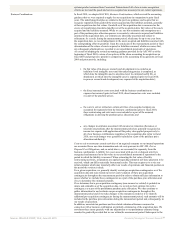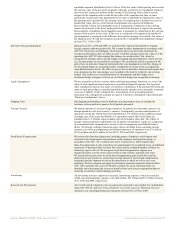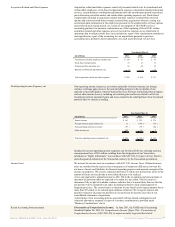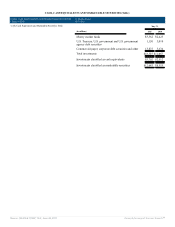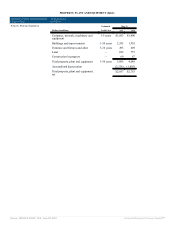Oracle 2010 Annual Report Download - page 215
Download and view the complete annual report
Please find page 215 of the 2010 Oracle annual report below. You can navigate through the pages in the report by either clicking on the pages listed below, or by using the keyword search tool below to find specific information within the annual report.
reportable segments identified in Note 16 below. If the fair value of the reporting unit exceeds
the carrying value of the net assets assigned to that unit, goodwill is not considered impaired
and we are not required to perform further testing. If the carrying value of the net assets
assigned to the reporting unit exceeds the fair value of the reporting unit, then we must
perform the second step of the impairment test in order to determine the implied fair value of
the reporting unit’s goodwill. If the carrying value of a reporting unit’s goodwill exceeds its
implied fair value, then we would record an impairment loss equal to the difference.
Recoverability of finite lived intangible assets is measured by comparison of the carrying
amount of each asset to the future undiscounted cash flows the asset is expected to generate.
Recoverability of indefinite lived intangible assets is measured by comparison of the carrying
amount of the asset to its fair value. If the asset is considered to be impaired, the amount of
any impairment is measured as the difference between the carrying value and the fair value of
the impaired asset. We did not recognize any goodwill or intangible asset impairment charges
in fiscal 2011, 2010 or 2009.
Derivative Financial Instruments During fiscal 2011, 2010 and 2009, we used derivative financial instruments to manage
foreign currency and interest rate risks. We account for these instruments in accordance with
ASC 815, Derivatives and Hedging, which requires that every derivative instrument be
recorded on the balance sheet as either an asset or liability measured at its fair value as of the
reporting date. ASC 815 also requires that changes in our derivatives’ fair values be
recognized in earnings, unless specific hedge accounting and documentation criteria are met
(i.e. the instruments are accounted for as hedges). We recorded the effective portions of the
gain or loss on derivative financial instruments that were designated as cash flow hedges or
net investment hedges in accumulated other comprehensive income in the accompanying
consolidated balance sheets. The offset to gain or loss on derivative financial instruments that
were designated as fair value hedges were recorded to the item for which the risk is being
hedged. Any ineffective or excluded portion of a designated cash flow hedge or net
investment hedge, and gains or losses on our fair value hedges are recognized in earnings.
Legal Contingencies We are currently involved in various claims and legal proceedings. Quarterly, we review the
status of each significant matter and assess our potential financial exposure. For legal and
other contingencies that are not a part of a business combination, if the potential loss from any
claim or legal proceeding is considered probable and the amount can be reasonably estimated,
we accrue a liability for the estimated loss. A description of our accounting policies
associated with contingencies assumed as a part of a business combination is provided under
“Business Combinations” above.
Shipping Costs Our shipping and handling costs for hardware systems products sales are included in
hardware systems products expenses for all periods presented.
Foreign Currency We transact business in various foreign currencies. In general, the functional currency of a
foreign operation is the local country’s currency. Consequently, revenues and expenses of
operations outside the United States are translated into U.S. Dollars using weighted average
exchange rates while assets and liabilities of operations outside the United States are
translated into U.S. Dollars using exchange rates at the balance sheet date. The effects of
foreign currency translation adjustments are included in stockholders’ equity as a component
of accumulated other comprehensive income in the accompanying consolidated balance
sheets. Net foreign exchange transaction gains (losses) included in non-operating income
(expense), net in the accompanying consolidated statements of operations were $11 million,
$(149) million and $(65) million in fiscal 2011, 2010 and 2009, respectively.
Stock-Based Compensation We account for share-based payments, including grants of employee stock options and
restricted stock-based awards and purchases under employee stock purchase plans, in
accordance with ASC 718, Compensation-Stock Compensation, which requires that
share-based payments (to the extent they are compensatory) be recognized in our consolidated
statements of operations based on their fair values and the estimated number of shares we
ultimately expect will vest. We recognize stock-based compensation expense on a
straight-line basis over the service period of the award, which is generally four years.
We record deferred tax assets for stock-based compensation plan awards that result in
deductions on our income tax returns based on the amount of stock-based compensation
recognized and the statutory tax rate in the jurisdiction in which we will receive a tax
deduction. We have adopted and apply the alternative transition method as defined within
ASC 718 to calculate the excess tax benefits available for use in offsetting future tax
shortfalls and to determine the excess tax benefits from stock-based compensation that we
reclassify as cash flows from financing activities.
Advertising All advertising costs are expensed as incurred. Advertising expenses, which are included
within sales and marketing expenses, were $88 million, $75 million and $71 million in fiscal
2011, 2010 and 2009, respectively.
Research and Development All research and development costs are expensed as incurred. Costs eligible for capitalization
under ASC 985-20, Software-Costs of Software to be Sold, Leased or Marketed, were not
material to our consolidated financial statements in fiscal 2011, 2010 or 2009.
Source: ORACLE CORP, 10-K, June 28, 2011 Powered by Morningstar® Document Research℠




